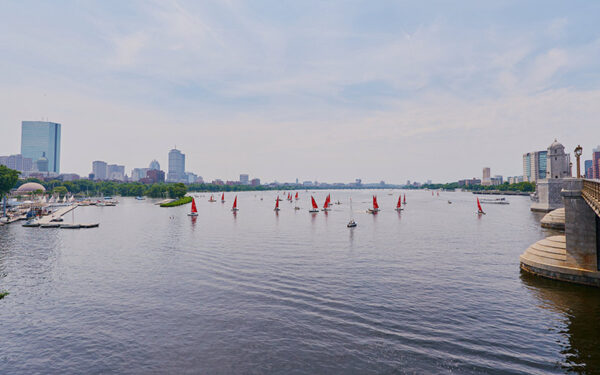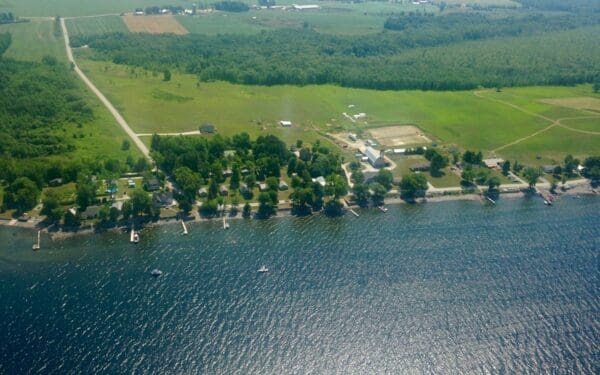
Birdwatchers know that visiting a healthy wetland, vernal pool, or small stream can help boost sightings since the presence of water plus plant and insect diversity is a bird magnet. These habitats are threateded by Trump administration rollbacks. Photo: Christina Wiseman
Christina Wiseman is the Advocacy Operations Manager at Mass Audubon, where she coordinates outreach around policy that protects nature, our climate, and our communities.
The first time I ever saw a Great Blue Heron I was around 10 years old, watching it descend into the wetlands behind our Cape Cod rental cottage. I was struck that day, and each time I’ve seen one since, by its grace: that slate blue color, those languid movements, and the way its presence made everyone pause to appreciate nature’s beauty for a moment.
If, like me, you’re ever marveled at the elegance of a wading bird or searched for salamanders on a spring evening, you’ve seen firsthand how important our wetlands and streams are to America’s wildlife.
Unfortunately, this habitat is now under threat.
Water protections in trouble
The Clean Water Act has helped safeguard America’s rivers, streams, lakes, and wetlands for nearly 50 years. Besides wildlife habitat, these interconnected landscapes also offer ecosystem services like flood control, swimming and fishing opportunities, and drinking water for millions of Americans.
But now, the U.S. Environmental Protection Agency and the Army Corps of Engineers have finalized a new rule removing critical protections for more than half of the country’s wetlands and hundreds of thousands of streams. The repeal focuses on the 2015 “Waters of the United States” rule (WOTUS), which, after extensive scientific and public input, defined the wetlands and waterways that receive protection under the Clean Water Act.
By excluding so many wetlands and streams from protection, this decision not only jeopardizes their health but also the health of the watersheds around them, since smaller and seasonal bodies of water help filter pollutants before they reach larger lakes and rivers.
What does this mean for our wildlife?
Of course, it’s not only our water that will be impacted. Losing federal protections for wetlands and streams means losing protection for the wildlife that call them home. Beloved species like yellow warblers, wood ducks, spring peepers, and dragonflies all rely on healthy wetland and aquatic ecosystems for breeding habitat and feeding grounds.
At Mass Audubon, we introduce people every day to the magic of nature, and wetlands and streams are a key part of the draw. Vernal pool explorations yield fairy shrimp and wood frogs. Sanctuary ponding programs help children of all ages discover the tiny creatures that live in our waters. Visitors thrill to watching beavers swimming by or basking turtles stacked along logs. Even the muddy shores of woodland pools or streams hold secrets as the best place to look for wildlife tracks. In fact, every site in Mass Audubon’s network of over 100 wildlife sanctuaries, from the Berkshires to Boston, is associated with some type of wetland system or water body.
Birdwatchers know that visiting a healthy wetland, vernal pool, or even a small stream can help boost sightings since the presence of water plus plant and insect diversity is a bird magnet. A perfect day is sitting quietly beside a vernal pool or babbling brook, waiting for the birds to arrive or the frogs to start calling. That tiny rivulet in the woods might just turn up a Louisiana waterthrush.
The challenges of a changing climate
These new federal threats are compounded by the fact that so much of our wildlife is already at risk from climate change. Of Massachusetts’s 143 breeding bird species evaluated by Mass Audubon, 43% are “highly vulnerable” to the effects of climate change. Nationally, we’ve already lost 3 billion birds in the past 50 years due to pollution and loss of habitat, and two-thirds of North American bird species are at further risk of extinction from climate change. Species associated with headwater wetlands and streams are particularly vulnerable, as shifting precipitation patterns and higher temperatures will lead to both more drought and more severe storm events — changes that will increasingly affect these areas’ suitability as habitat.
Healthier wetlands mean better climate resilience. They absorb floodwater, buffer against storm damage, and act as carbon sinks. That’s why it’s so important that we prevent the federal government from making them more vulnerable.
Taking action
Mass Audubon has joined Conservation Law Foundation, Natural Resources Defense Council, and other partners in filing a lawsuit challenging the Trump administration’s rollbacks. By taking this action, we’re letting our government know that we won’t stand by while they put our natural resources at risk.
To protect our water resources, we need to look at them as the interconnected, holistic system that they are. We need to remember that water is a shared resource. It’s shared by those that rely on local aquifers for clean drinking water, by aquatic and wetland wildlife, and by anyone who’s ever spent a hot summer day swimming in the lake or marveling at a backyard chorus of spring peepers.
At Mass Audubon, a strong Clean Water Act ensures that generation after generation can continue to be inspired by nature. That’s why we’re fighting to protect it.
This post also had input from Martha Gach and Tom Lautzenheiser.



